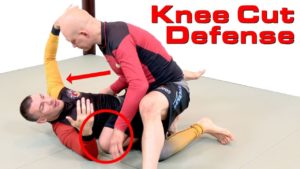The Knee Cut Pass is one of the most powerful and most commonly used guard passes in all of grappling.
This pass uses the knee to pin the opponent’s leg, opening the opportunity to slide across to the other side of his body. It’s used in BJJ with the gi, submission grappling with spandex and shorts, and even in MMA.
The knee cut is a very powerful pass, and if you’re a grappler you absolutely, positively, need some good defenses against it
Here’s BJJ Black Belt Jon Thomas (of Open Guard System fame showing 3 of the highest percentage knee cut guard pass counters…
Let’s recap some of the most important lessons taught by Jon Thomas in the video above…
Core Principle: Elbow-Knee Connection
One of the most important concepts in preventing the knee cut guard pass (and most other guard passes too) is maintaining elbow-knee connection.
Simply put, someone working to pass your guard is trying to invade the space between your elbow and your knee. Once he does that he can get in tight against your ribs and your hips, thus controlling your torso.

Here white has broken black’s elbow-knee connection with his own knee and is dominating the inside space against black’s body.
By keeping your knee and your elbow connected you deny him that space, making the pass much, much harder.
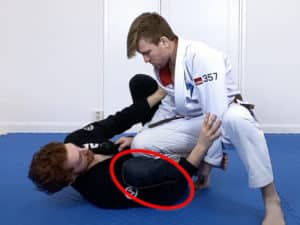
Here black is using elbow-knee connection to block white’s knee from getting next to his body and thus make the guard pass much harder.
It’s counter-intuitive, but many high level players like to bring their knee and shin above their biceps when they’re defending a guard pass.
Essentially this forms a four layer sandwich.
- The guard passer’s knee on top
- Then the defender’s knee and shin
- Then the defender’s upper arm
- And then the floor.
Now that we’ve covered the core concept of knee-elbow connection let’s look at the 3 separate counters themselves…
Knee Cut Counter 1: Leg Lasso
The leg lasso is a position where you secure your opponent’s wrist and loop your leg up around the outside of his arm, placing your foot either shallowly on his shoulder or deeply through his armpit.
We’ll be looking at how to use the leg lasso defensively to prevent the guard pass, but once you have your leg in this configuration you can transition very easily to the offensive leg lasso spider guard.
This leg lasso counter to the knee cut still works defensively in no gi. The offensive followup options probably won’t work in no gi, but at least you’ve still stopped him from passing your guard.

Your opponent has initiated the knee cut guard pass. Bring your knee towards your chest and over your own arm to maintain elbow-knee connection and block his arms with your hands.
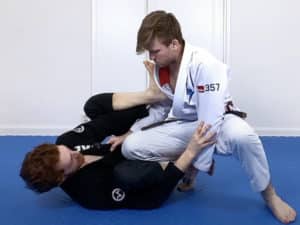
Loop your left leg to the outside, over his arm and onto the biceps/shoulder area to form a shallow lasso hook
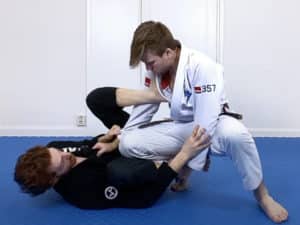
Control the sleeve of his right arm with your left hand.
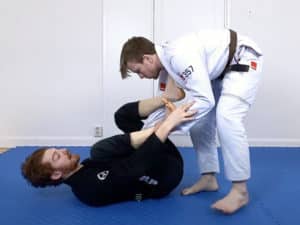
Push him away with our foot to reset and then and start attacking from the leg lasso spider guard.
Knee Cut Counter 2: Foot on Biceps
In this counter you’re prevented from circling your leg into position, so you’ll take a different route to block him.
Instead bringing your foot outside his arm and into a leg lasso position you’ll bring it up on the inside and go directly to the foot on biceps position. At this point you can use your leg as a distance and control mechanism to keep him at your preferred range.
Once again, this guard retention technique works equally well in the gi and in no gi.
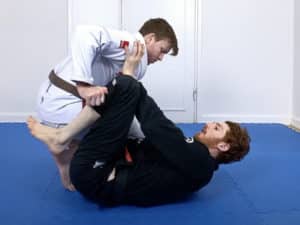
He enters into the knee cut guard pass holding your pant leg which makes looping your leg to outside difficult
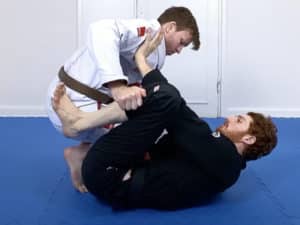
Frame at the shoulders with both arms
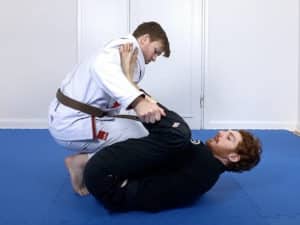
Bring your foot up along his body and directly to his biceps
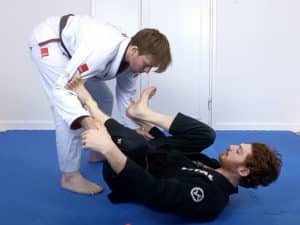
Push down and backwards with your foot to reset the guard
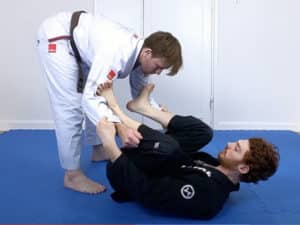
In the gi you can now control his sleeves to establish the double foot on biceps spider guard.
Knee Cut Counter 3: Knee Shield
Sometimes your opponent will initiate the knee cut while effectively blocking your leg from looping around his arm or coming up under it. In that case you’re left with the knee shield.
In a knee shield position you bring your top knee sideways, across his hips, using your leg as a frame to hold him off.
The knee shield temporarily blocks his forward progress, but it won’t last forever. You need to move quick to stop him from countering your counter

He enters into the knee cut and all you can do is bring your top knee across his leading hip

To strip his grip establish your knee shield over his forearm and then push your knee away

Now get a grip (4 fingers in) on his cross collar
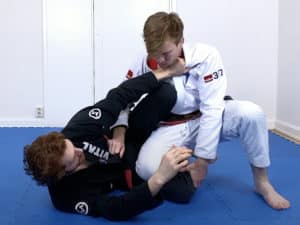
Stiff-arm to frame him away
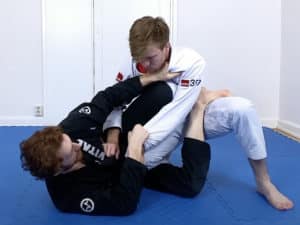
Use the space generated to reinsert your bottom leg and control his left sleeve to start your offense.

ALTERNATELY If you can’t get your foot back on his hip then sit up on your elbow…
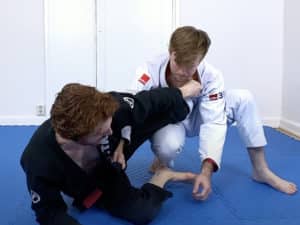
Then scoot back while resting your weight on his right thigh with your left knee and then and then rip your bottom leg backwards to free it…
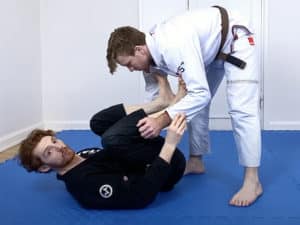
Then square up to him and reset your guard.
Jon Thomas and The Open Guard System
The techniques above came from the Open Guard System System with Jon Thomas that I produced.
This 5 volume instructional covers the de la Riva guard, the double sleeve guard, and the collar sleeve guard, gripfighting and guard retention.
It’s available in online streaming format, DVD format, and now also as a module within the Grapplearts BJJ Master App.
You’ll get the highest percentage attacks, and then learn exactly how to use them together so you can respond to whatever your opponent does in real time.
Click here to check it out – with the sale price and the guarantee I think it’s a Mafia offer (one you can’t refuse),
Related Resources
Range and Distance in Guard
There’s an organising principle that brings order to the chaos of different styles of guard… A concept that tells you when you should use which guard… A heuristic that simplifies your decision making process about what technique to use when.
And that concept is range.
The different forms of guard are range dependent – how far you are from your opponent.
If this is a topic you’d like to understand better then check out this detailed article and video about range and distance in the guard on this site.
Five More Knee Cut Defenses
The knee cut is powerful but it’s NOT a magic guard pass that works every time… You DON’T have to let the other guy pass if he tries it… There ARE defenses and counters to it!
In fact, in this article Rob Biernacki and I break down 5 defenses that work early, middle and late in the guard pass.
12 Concepts, Principles and Ideas To Stop Your Opponent from Passing Your Guard
Here’s a really detailed, super comprehensive video on the 12 most important concepts and ideas that’ll make your guard much harder to pass.
It’s the best thing you’ll watch today. Seriously.
Click here to check out 12 Concepts, Principles and Ideas To Stop Your Opponent from Passing Your Guard
The post 3 Great Knee Cut Counters appeared first on Grapplearts.



